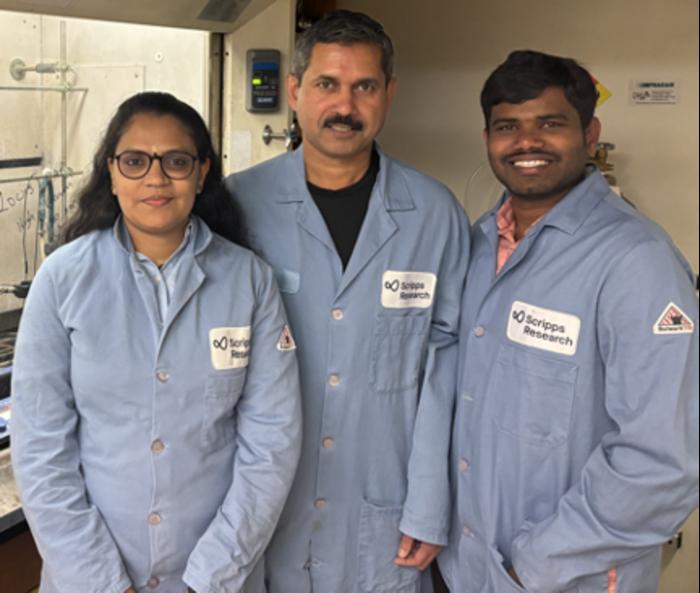LA JOLLA, CA—Roughly 4 billion years ago, Earth was developing conditions suitable for life. Origin-of-life scientists often wonder if the type of chemistry found on the early Earth was similar to what life requires today. They know that spherical collections of fats, called protocells, were the precursor to cells during this emergence of life. But how did simple protocells first arise and diversify to eventually lead to life on Earth?

Credit: Scripps Research
LA JOLLA, CA—Roughly 4 billion years ago, Earth was developing conditions suitable for life. Origin-of-life scientists often wonder if the type of chemistry found on the early Earth was similar to what life requires today. They know that spherical collections of fats, called protocells, were the precursor to cells during this emergence of life. But how did simple protocells first arise and diversify to eventually lead to life on Earth?
Now, Scripps Research scientists have discovered one plausible pathway for how protocells may have first formed and chemically progressed to allow for a diversity of functions.
The findings, published online on February 29, 2024, in the journal Chem, suggest that a chemical process called phosphorylation (where phosphate groups are added to the molecule) may have occurred earlier than previously expected. This would lead to more structurally complex, double chained protocells capable of harboring chemical reactions and dividing with a diverse range of functionalities. By revealing how protocells formed, scientists can better understand how early evolution could have taken place.
“At some point, we all wonder where we came from. We’ve now discovered a plausible way that phosphates could have been incorporated into cell-like structures earlier than previously thought, which lays the building blocks for life,” says Ramanarayanan Krishnamurthy, PhD, co-corresponding senior author and professor in the Department of Chemistry at Scripps Research. “This finding helps us better understand the chemical environments of early Earth so we can uncover the origins of life and how life can evolve on early Earth.”
Krishnamurthy and his team study how chemical processes occurred to cause the simple chemicals and formations that were present before the emergence of life in prebiotic Earth. Krishnamurthy is also a co-leader of a NASA initiative investigating how life emerged from these early environments.
In this study, Krishnamurthy and his team collaborated with the lab of soft matter biophysicist Ashok Deniz, PhD, co-corresponding senior author and professor in the Department of Integrative Structural and Computational Biology at Scripps Research. They sought to examine if phosphates may have been involved during the formation of protocells. Phosphates are present in nearly every chemical reaction in the body, so Krishnamurthy suspected they may have been present earlier than previously believed.
Scientists thought protocells formed from fatty acids, but it was unclear how protocells transitioned from a single chain to a double chain of phosphates, which is what allows them to be more stable and harbor chemical reactions.
The scientists wanted to mimic plausible prebiotic conditions—the environments that existed prior to the emergence of life. They first identified three likely mixtures of chemicals that could potentially create vesicles, spherical structures of lipids similar to protocells. The chemicals used included fatty acids and glycerol (a common byproduct of soap production that may have existed during early Earth). Next, they observed the reactions of these mixtures and added additional chemicals to create new mixtures. These solutions were cooled and heated on repeat overnight with some shaking to promote chemical reactions.
They then used fluorescent dyes to inspect the mixtures and judge if vesicle formation had taken place. In certain cases, the researchers also varied the pH and the ratios of the components to better understand how these factors impacted vesicle formation. They also looked at the effect of metal ions and temperature on the stability of the vesicles.
“The vesicles were able to transition from a fatty acid environment to a phospholipid environment during our experiments, suggesting a similar chemical environment could have existed 4 billion years ago,” says first author Sunil Pulletikurti, postdoctoral researcher in Krishnamurthy’s lab.
It turns out that fatty acids and glycerol may have undergone phosphorylation to create that more stable, double chain structure. In particular, glycerol derived fatty acid esters may have led to vesicles with different tolerances to metal ions, temperatures, and pH—a critical step in diversifying evolution.
“We’ve discovered one plausible pathway for how phospholipids could have emerged during this chemical evolutionary process,” says Deniz. “It’s exciting to uncover how early chemistries may have transitioned to allow for life on Earth. Our findings also hint at a wealth of intriguing physics that may have played key functional roles along the way to modern cells.”
Next, the scientists plan to examine why some of the vesicles fused while others divided to better understand the dynamic processes of protocells.
Authors of the study, “Experimentally Modeling the Emergence of Prebiotically Plausible Phospholipid Vesicles” include Sunil Pulletikurti, Veena S. Kollery, Mahipal Yadav, Ashok A. Deniz, and Ramanarayanan Krishnamurthy of Scripps Research.
The work was supported by the NASA Astrobiology-Exobiology (grant 80NSSC20K0625) and Simons Foundation (grant 327124FY19).
About Scripps Research
Scripps Research is an independent, nonprofit biomedical institute ranked one of the most influential in the world for its impact on innovation by Nature Index. We are advancing human health through profound discoveries that address pressing medical concerns around the globe. Our drug discovery and development division, Calibr, works hand-in-hand with scientists across disciplines to bring new medicines to patients as quickly and efficiently as possible, while teams at Scripps Research Translational Institute harness genomics, digital medicine and cutting-edge informatics to understand individual health and render more effective healthcare. Scripps Research also trains the next generation of leading scientists at our Skaggs Graduate School, consistently named among the top 10 US programs for chemistry and biological sciences. Learn more at www.scripps.edu.
Journal
Chem




